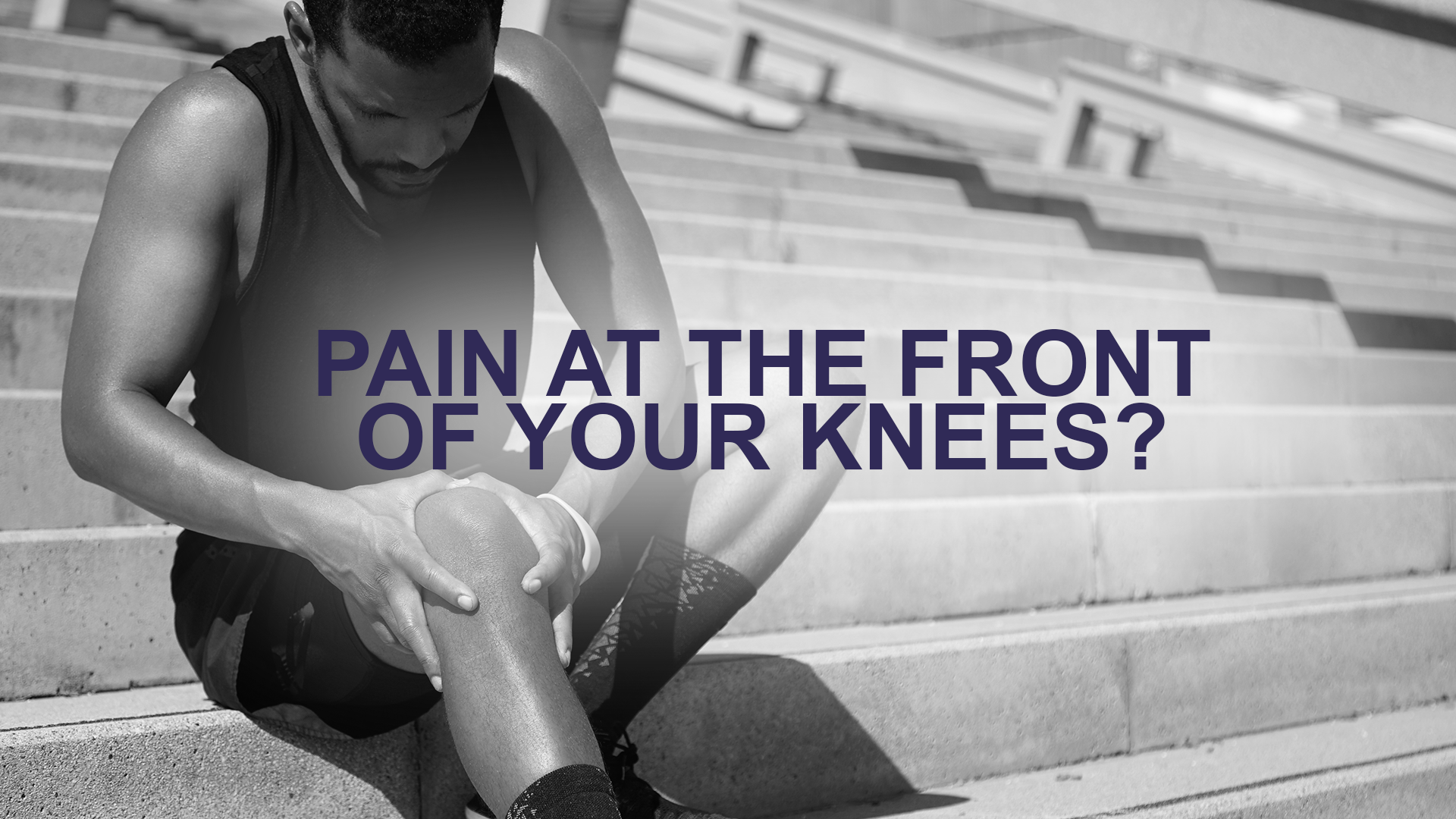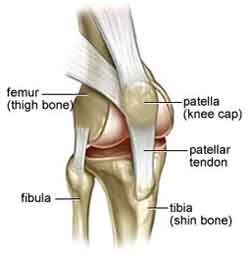Pain at the front of your knees?
Why does the front of my knee hurt?
There are a plethora of reasons as to why people suffer anterior knee pain. In this article we are going to focus on one of the more common causes which is patellar tendinopathy.
Patellar tendinopathy?
The patellar tendon serves as the attachment for the quadriceps muscles via the patella into the front of the tibia. Due to the large frequent forces that it takes, it is at a very high risk to overuse injuries. Chronic patellar tendon injuries (Patellar tendonosis) is often referred to as “Jumper’s Knee” which is very common among jumping sports such as volleyball (44%) and basketball (32%)(1). It is also seen among athletes requiring repetitive kicking, jumping and landing such as soccer and dancing.
How is it injured and what’s the prognosis?
Microtrauma occurs when the tendon is subjected to extreme forces such as acceleration, deceleration, jumping and landing. Prevalence is higher in skeletally mature adolescents or adults, 16 to 40 years with equal rates between genders(2). Acute tendinitis involving an active inflammatory process, if treated correctly, can heal in 3-6 weeks. Chronic patellar tendinopathy involves degenerative changes which occur 6 weeks to 3 months post injury. These changes are notable for the absence of the inflammatory cycle as well as decreased quality and disorganisation of collagen fibers which leads to decreased tensile strength(3). Neovascularisation, the growth of new vasculature in areas of poor blood supply may lead to increased levels of pain(4). Overuse by athletes leads to this chronic stage which ends up taking 3-6 months to heal.
Factors that contribute to patellar tendinopathy
Signs and Symptoms
Signs and symptoms vary on the severity and the period of time passed since original injury. Your physiotherapist can use Blazina’s knee scale(6) or Kennedy’s scale(7) to determine severity level. Normally there is pain on touching the inferior pole of the patella as well as recurrent episodes of pain within the body of the tendon. Pain can also be reproduced through resisted knee extensions. Functional tasks involving stairs, hopping/jumping as well as squatting can normally induce the person’s pain.
Differential Diagnosis
Your physiotherapist can identify this condition through a thorough history taking and a complete objective examination. Other conditions with similar presentations include 1) Patellofemoral dysfunction, 2) Sinding-Larsen-Johansson Syndrome and 3) Osgood Schlatter’s disease
Rehabilitation
Stage 1: Initial Rehabilitation Controlled Rest
This involves ceasing any activity that was causing the overuse and to practice controlled exercises without load. All jumping and deep squatting activities are to be avoided. Stationary cycling and hydrotherapy helps to maintain stamina while keeping the tendon unloaded. Depending on your physiotherapist’s rating of severity, for low severity injuries training may need to be adapted and for highly severe injuries, total rest from aggravating activities may be required. Visnes et al deduced that patients should cease sports participation while undergoing an eccentric-only rehab program, then resume sports after 8 weeks with a gradual return to high intensity over 4 weeks(8).
Eccentric exercises has been shown to be most effective except that the various protocols disagree on the level of pain that should be present on exercising. The Alfredson protocol allows eccentric exercise intensity up to 5/10(9) while Stanish and Curwin suggest only performing eccentric exercises if pain free(10).
Initial treatment involves the absence of aggravating activities with relative rest, stretching of lower limb musculature, deep transverse friction massage of the patellar tendon, eccentric quadriceps exercises, strengthening of hip and knee, utilisation of a patellar orthotic (if required) and cryotherapy. As inflammatory cells are absent in tendinosis cases, NSAIDs are usually not effective. Cortisone injections may negatively affect strength and increase risk of tendon rupture.
A warm up and stretching period is required before exercise. Stationary cycling for 5-10 mins with minimal resistance will be sufficient for a warm up. Stretching should be performed before and after the exercise, targeting hip flexors, quadriceps, hamstrings, gastrocnemius and soleus. Evidence has shown a minimum of 30 seconds static stretches performed three to four times daily has helped to improve flexibility(11).
Soft tissue mobilisations such as deep transverse friction massage for 5-10 minutes twice daily helps to promote normal collagen growth. This technique has shown to assist in regaining tensile strength and proper fiber orientation when performed on the tissue under tension(12).
Eccentric exercises are key in the rehabilitation process, eccentric squats on a 25 degree decline board for 15 reps x 3 sets twice daily has been shown to be effective. A decline board increases loading on the patellar tendon by 25-30% whereas squatting on a flat surface more likely targets the quadriceps muscle(13). It is advised to start in partial weight bearing environment such as a pool where the patient performs the decline squats in shoulder deep water, progressing to waist deep then shallower levels of water. A patient is ready to progress when they can complete 3 sets of 15 reps of eccentric squats on a decline board. Progression goes from bilateral eccentric squats, to unilateral eccentric squats to concentric-eccentric contractions(14). Initially, during the concentric phase, the unaffected leg should be used followed by bilateral eccentric contraction. Slow speeds are recommended for the first week, with a gradual increase of speed weekly.
Squatting depth is a controversial topic, certain papers arguing for a limit of 60-70 degrees(15) while other studies have found 90 degrees to be the beneficial cut off point(16).
Hip strengthening is vital with straight leg raises, side-lying hip abduction/adduction and hip extension exercises to be performed with emphasis on the eccentric lowering part. A 2 second concentric followed by a 4 second eccentric lowering has been shown to be beneficial(17).
Other treatment options that exist is the use of cryotherapy, taping, patellar orthotics, low level laser, extracorporeal shock wave therapy, iontophoresis, ultrasound and electrical stimulation which may help with healing and lead to better outcomes. Your physiotherapist can advise on which may be suitable for your condition.
Stage 2: Progression
After pain symptoms decrease, progress the patient to upright 25 degree decline eccentric squats (3 sets of 15 reps twice daily). Progress from bilateral to unilateral, eccentric-concentric as stated above. The exercise should advance from partial weight bearing in the pool to full weight bearing, then to weighted resistance using a back pack or weighted vest. Speed can be progressed gradually, before progressing to more ballistic type activities (jump squats) to prepare for functional activities. Even when after the symptoms have faded, eccentric exercises should be continued.
When adding weight, start with 10% of body weight and add 5kg increments as appropriate(18). Double leg jumping squats can be initiated at week 4-5 at a level that does not produce pain. The hip strengthening exercises can be progressed by the addition of ankle weights, while cross friction massage can be continued. At 4 weeks, slow pain free jogging on flat ground can be initiated as well as resisted cycling and aqua jogging(19). Only after 8 weeks, can a return to sport be suggested.
Stage 3: Return to Play
Continue adding the 5kg incremental weights on the eccentric decline squats. Progress to a drop squat, rapid eccentric drop into the squat position (3 sets of 20 reps) adding the incremental weight as appropriate(20). Three sets of 15 reps daily of eccentric step downs off 4”, 6” and 8” height steps with minimal to no discomfort. Following pain-free movement of the 6-8” step downs, progress to drop jumps(21). Progression includes jumping off a 4” step and then progressing to 6-8” steps when 3 sets of 20 reps daily becomes easy. Forward and backward hop jumps, side to side jumps, jumping rope and run and turn activities such as figure of 8’s should be performed. Running and kicking should be started in this stage.
Below is a protocol put forward by Rutland et al that covers what a patient should be performing weekly (22).
Bibliography
1) Lian, O. B., Engebretsen, L. and Bahr, R. (2005) ‘Prevalence of jumper's knee among elite athletes from different sports’, American Journal of Sports Medicine, 33(4) 561–67.
2) Cook, J. L., Khan, K. M. and Maffulli, N.(2000) ‘Overuse tendinosis, not tendinitis. Part 2: applying the new approach to patellar tendinopathy’, The Physical and Sports Medicine,28(6) 1–11.
3) Cook, J. L., Khan, K. M. and Purdam, C. R. (2001) 'Conservative treatment of patellar tendinopathy', Physical Therapy in Sport, 35(5) 291-94.
4) Ohberg, L., Lorentzon, R. and Alfredson, H. (2001) 'Neovascularisation in Achilles tendons with painful tendinosis but not in normal tendons: an ultrasonographic investigation', Knee Surgery Sports Traumatology Arthroscopy, 9(4) 233–38.
5) Magra, M. and Maffulli, N. (2008) 'Genetic aspects of tendinopathy', Journal of Science and Medicine Sport, 11(3) 243–47.
6) Blazina, M. E., Kerlan, R. K., Jobe, F. W., Carter, V. S. and Carlson, G. J. (1973) 'Jumper's knee', Orthopedic Clinician of North America, 4(3):665–78.
7) Kennedy, J. C., Hawkins, R. and Krissoff, W. B. (1978) 'Orthopaedic manifestations of swimming', American Journal of Sports Medicine, 6(6) 309–21.
8) Visnes, H. and Bahr, R. (2007) 'The evolution of eccentric training as treatment for patellar tendinopathy (jumper's knee): a critical review of exercise programmes', British Journal of Sports Medicine, 41(4) 217–23.
9) Alfredson, H., Peitila, T., Jonsson, P. and Lrentzon, R. (1998) 'Heavy-load eccentric calf muscle training for the treatment of chronic Achilles tendinosis', American Journal of Sports Medicine, 26, 360–66.
10) Stanish, W. D., Rubinovich, R. M and Curwin, S. (1986) 'Eccentric exercise in chronic tendinitis', Clinical Orthopedic Relations Res, 208:65–8.
11) Youdas, J. W., Krause, D. A., Egan, K. S et al (2003) 'The effect of static stretching of the calf muscle-tendon unit on active ankle dorsiflexion range of motion', Journal of Orthopedic Sports Physical Therapy, 33(7) 408–17.
12) Hunter, G. (2000) 'The conservative management of Achilles tendinopathy', Physical Therapy in Sport, 1:6–14.
13) Frohm, A., Saartok, T., Halvorsen, K. and Renstrom, P. (2007) 'Eccentric treatment for patellar tendinopathy: a prospective randomised short-term pilot study of two rehabilitation protocols', British Journal of Sports Medicine, 41;e7.
14) Silbernagel, K. G., Thomee, R., Thomee, P. et al. (2001) 'Eccentric overload training for patients with chronic Achilles tendon pain-a randomized controlled study with reliability testing of the evaluation methods', Scandinavian Journal of Medicine and Science Sports, 11(4) 197–206.
15) Zwerver, J., Bredeweg, S. W. and Hof, A. L. (2007) 'Biomechanical analysis of the single-leg decline squat', British Journal of Sports Medicine, 41(4) 264–68.
16) Jonsson, P. and Alfredson, H. (2005) 'Superior results with eccentric compared to concentric quadriceps training in patients with jumper's knee: a prospective randomised study', British Journal of Sports Medicine, 39(11) 847–50.
17) Ireland, M. L., Willson, J. D., Ballantyne, B. et al (2003) 'Hip strength in females with and without patellofemoral pain', Journal of Orthopedic Sports Physical Therapy, 33(11) 671–76.
18) Young, M. A., Cook, J. L., Purdam, C. R. et al. (2005) 'Eccentric decline squat protocol offers superior results at 12 months compared with traditional eccentric protocol for patellar tendinopathy in volleyball players', British Journal of Sports Medicine, 39(4) 102–5.
19) Purdam, C. R., Johsson, P., Alfredson, H. et al. (2004) 'A pilot study of the eccentric decline squat in the management of painful chronic patellar tendinopathy', British Journal of Sports Medicine, 38(4) 395–97.
20) Cannell, L. J., Taunton, J. E., Clement, D. B. et al (2001) 'A randomised clinical trial of the efficacy of drop squats or leg extension/leg curl exercises to treat clinically diagnosed jumper's knee in athletes: pilot study', British Journal of Sports Medicine, 35(1) 60–4.
21) Basso, O., Amis, A. A., Race, A. et al (2002) 'Patellar Tendon Fiber Strains: Their Differential Responses to Quadriceps Tension Basso', Clinical Orthopedic Relations Res, July (400) 246–53.
22) Rutland, M., O'Connell, D., Brismee, J. M., Sizer, P., Apte, G. and O'Connell, J. (2010) 'Evidence-supported rehabilitation of patellar tendinopathy', North American Journal of Sports Physical Therapy, 5(3) 166-178.







